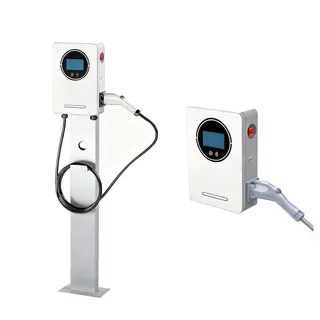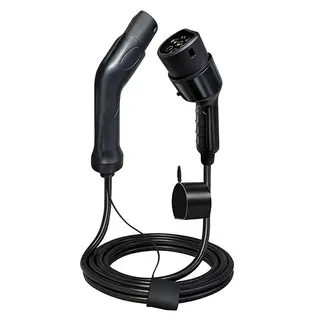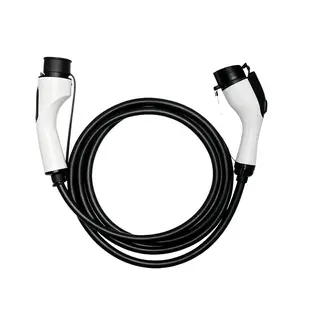In today's rapidly developing new energy vehicle industry, ev chargers serve as the "energy supply stations" for electric vehicles and play an indispensable role. According to their installation location, electric vehicle chargers are mainly divided into on-board chargers and off-board chargers. Today, let us take an in-depth look at the characteristics, working principles, and their important role in the electric vehicle ecosystem.
An on-board charger is fixedly installed inside the vehicle and closely connected with the vehicle's electrical system, becoming an indispensable part of the vehicle. This design not only makes charging more convenient but also lays a solid foundation for the popularization of electric vehicles. Next, let us take a detailed look at the structure, working principle, and the important role of on-board chargers in the electric vehicle ecosystem.
The on-board charger (On-Board Charger, OBC) is a charging device fixedly installed on electric vehicles. Its main task is to convert AC power into DC power to directly charge the electric vehicle's traction battery. From a structural perspective, the on-board charger mainly consists of a power circuit and a control circuit.
The power circuit includes components such as AC rectifiers, transformers, and power transistors, with the DC/DC converter as the core part, responsible for converting AC into DC suitable for battery charging. The control circuit, through communication with the Battery Management System (BMS), dynamically adjusts the charging current and voltage according to the real-time status of the battery, ensuring that the charging process is both safe and efficient.
The greatest advantage of on-board chargers lies in their convenience. As long as there is a suitable AC power outlet, vehicle owners can charge their vehicles anytime and anywhere. This flexibility greatly expands the usage scenarios of electric vehicles. Whether at home, in workplace parking lots, or in shopping malls with available outlets, charging can be easily completed.
However, on-board chargers also have some limitations. Due to the constraints of vehicle space and weight, their size and power are relatively small, usually only capable of providing low-current slow charging. This means the charging time is relatively long, which may not be ideal for users who need rapid charging. In addition, the power handling capacity of on-board chargers is limited, making them unable to meet the needs of high-power fast charging.
Despite some limitations, on-board chargers still play an important role in the daily use of electric vehicles. They provide fundamental support for the popularization of electric vehicles, allowing vehicles to conveniently recharge even in the absence of specialized charging facilities. For most owners, overnight slow charging at home using an on-board charger can meet daily commuting and nearby urban travel needs. Moreover, slow charging has a certain protective effect on battery life, helping to extend the battery's service life.
Off-board chargers provide fast recharging solutions with powerful charging capability and efficient energy conversion, greatly improving the convenience of electric vehicle use. Off-board chargers are usually installed in fixed locations such as parking lots, highway service areas, and commercial centers, providing rapid charging services for electric vehicles.
Off-board chargers can be further divided into AC charging stations and DC charging stations according to the form of output power.
AC charging stations: Both input and output are AC. They cannot directly charge the traction battery and require the vehicle's on-board charger to perform AC-to-DC conversion for charging. The internal structure of AC charging stations is relatively simple. Its basic function is to bring AC power from the grid to a convenient location for electric vehicle charging and provide a standard charging interface. Since its power is limited by the on-board charger's capacity, it generally does not need to be large.
DC charging stations: These are more efficient charging devices. Their input is AC, but the output is DC, which can directly charge the EV's traction battery. DC charging stations have higher power and can provide high-current fast charging, greatly shortening the charging time. This fast-charging capability makes DC charging stations widely used in locations requiring quick recharging, such as highway service areas and large shopping center parking lots.
Off-board chargers consist of multiple key components, including a power unit, control unit, metering unit, charging interface, power supply interface, and human-machine interaction interface.
The power unit is responsible for converting AC to DC.
The control unit precisely controls the charging process based on battery status and charging requirements.
The metering unit accurately measures the charging energy.
The charging interface and power supply interface ensure stable connection during charging.
The human-machine interaction interface allows users to operate and monitor the charging status conveniently.
These components work together, enabling off-board chargers to efficiently and safely charge electric vehicles.
The greatest advantage of off-board chargers lies in their powerful charging capability. Especially DC charging stations, which can quickly fully charge an electric vehicle, greatly improving the convenience of use. This rapid charging ability is particularly important for long-distance travel and emergency scenarios.
However, off-board chargers also face some challenges. Due to their large power, their size and weight are relatively large, construction costs are high, and installation and maintenance require specialized technology and equipment. In addition, due to their fixed installation, the flexibility of charging locations is limited, unlike on-board chargers that can charge anywhere. Moreover, frequent use of high-power fast charging can have a negative impact on battery life, so charging methods must be reasonably planned in practice.
After understanding the characteristics and advantages of both on-board and off-board chargers, it is helpful to compare them comprehensively to clearly see their differences in various dimensions, helping vehicle owners and related professionals make better choices based on their needs.
In terms of power and charging speed, off-board chargers, especially DC charging stations, have obvious advantages. Not restricted by vehicle space, multiple charging modules can be stacked to achieve higher power, providing high-current fast charging and greatly shortening charging time. On-board chargers, due to limitations in size and power, can only provide low-current slow charging, resulting in longer charging times. For example, an electric vehicle using an on-board charger may take several hours to fully charge, while a DC charging station may only take tens of minutes.
On-board chargers are fixedly installed on electric vehicles and integrated with the vehicle, offering high flexibility. Charging can be done anywhere with an AC power outlet. Off-board chargers, however, are installed in fixed locations such as parking lots or service areas, with relatively limited flexibility. Users must drive to locations with charging facilities to charge their vehicles.
From a cost perspective, on-board chargers are relatively low-cost, as they are part of the vehicle and included in the overall vehicle price. Off-board chargers, especially DC charging stations, are more expensive, covering equipment procurement, installation, and maintenance. Additionally, maintenance requires professional technicians and equipment, making it more costly.
In terms of battery life, slow charging using on-board chargers has relative advantages. During slow charging, battery temperature changes are smaller, causing less internal structural damage, which helps extend battery life. High-power fast charging using off-board chargers can quickly replenish energy but may negatively affect battery life if used frequently. Therefore, in practice, it is recommended to primarily use slow charging and supplement with fast charging, arranging charging methods reasonably to protect battery life.
As a key device for energy supply in electric vehicles, chargers play a crucial role in the development of new energy vehicles. On-board chargers, with their convenience and flexibility, provide fundamental support for daily EV use. Off-board chargers, with their powerful charging capability and fast-charging characteristics, meet the charging needs of EVs in special scenarios.
Although both have advantages and limitations, together they strongly support the popularization and development of electric vehicles.
With continuous technological advancement, charger performance will continue to improve, and charging methods will become more diversified. Whether on-board or off-board chargers, both are moving toward higher efficiency, smarter operation, and safer use. In the future, with the continuous improvement of charging infrastructure and innovation in charging technology, electric vehicle usage will become more convenient and efficient, and the widespread adoption of new energy vehicles is just around the corner.



